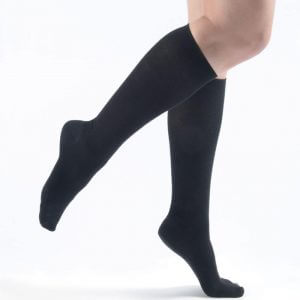As a person walks, the contraction and relaxation of the calf muscles around the veins aid in moving blood towards the heart. People with certain medical conditions, who are pregnant or those who sit or stand for long periods of time may have challenges moving the blood upwards. Blood in your legs have to work against gravity to return to the heart. Anything that impedes that flow—such as circulation problems, lack of movement (especially after an injury or surgery), or weakness in the walls of the veins of the legs (referred to as venous insufficiency)—results in blood pooling in the veins of the lower legs or feet. This can lead to swelling, achiness and leg fatigue. It could also predispose you to a venous clot.
Perhaps the most important effect that compression socks have is that they increase the pressure in the tissue under the skin (subcutaneous) thereby helping to reduce and prevent swelling. This helps move excess fluid (swelling) back into the capillaries and helps prevent too much fluid from leaking out of these little vessels. Essentially, compression socks or stockings act as a layer of muscle by gently squeezing the stretched vein walls together, allowing the valves to close. The cavity of the vein is reduced, thereby restoring blood flow to a normal state and aiding overall circulation.
You would benefit from wearing compression socks or stockings if you:
-have deep vein thrombosis (DVT).
-are on prolonged bed rest
-sit for long periods of time
-stand for long periods of time
-have varicose veins
-use birth control pills or hormone replacement therapy
-are pregnant
How to Use Compression Socks & Stockings
Compression socks & stockings come in a variety of sizes, lengths and colours. They’re also available with different strengths of compression depending on your needs. Medical grade graduated compression comes in different prescriptive levels based on the degree of compression ranging 15-20, 20-30, and 30-40 mmHg. After an evaluation at Pedorthic Works, our team can prescribe the best compression socks for your condition.
To be most effective, the compression socks or stockings should be put on first thing in the morning and removed just before you go to bed. If you wait until later in the morning to put on your socks, the blood will have already begun to pool in your lower legs and feet.
Compression Sock Care
Your compression socks should be washed after every use. You should obtain at least two pairs of socks if you’re wearing them on both legs. This means you can wear one pair while the other pair is being washed and dried. Hand wash your compression socks at about 40C /104F (comfortable hand temperature) and dry them away from direct heat. Plan on replacing your compression socks every 4 to 6 months.
Prevention with Compression Stockings
Even if you don’t suffer from varicose veins an ounce of prevention is worth a pound of cure. Wearing compression socks along with regular exercise, healthy weight management, elevation of your legs, and saving your high heels for special occasions will help ward off possible future issues. We recommend wearing compression even if you have no signs or symptoms of varicose or spider veins.

